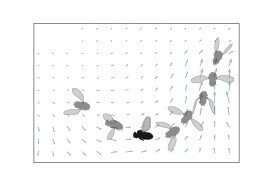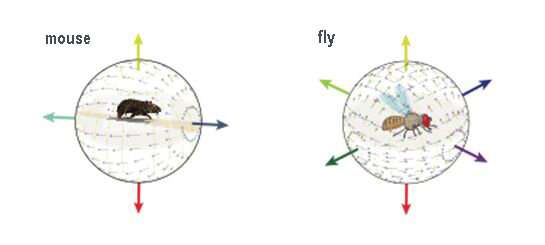Local motion detectors in fruit flies sense complex patterns generated by their own motion

Simple behaviors such as walking or driving require the human eye to process complex visual cues to allow proper navigation. A fly eye needs to accomplish even more to guide appropriate behavioral responses during flight. The fruit fly Drosophila melanogaster relies on rapid detection and processing of information from its eyes to its nervous system to adjust its behavior to an ever-changing environment. Scientists at Johannes Gutenberg University Mainz (JGU) have gained new insights into how the eye of Drosophila processes motion patterns that are generated by self-motion through space. They have discovered that direction-selective cells can distinguish six types of global motion patterns. "We thought that the visual system of Drosophila first detects the four cardinal directions of motion, i.e., front-to-back, back-to-front, upward, and downward," said Professor Marion Silies, the leader of the study. "However, the computation of the motion patterns we have now discovered matches Drosophila's actual behavior much closer."
Each T4/T5 subtype can recognize one specific motion pattern
A fruit fly's compound eye consists of 800 visual units organized in a hexagonal array. Each individual eye, in turn, is equipped with multiple photoreceptors, which pick up light stimuli from the environment. From here, the information is then processed in the visual system and transmitted to the central nervous system.
On the way from the photoreceptors to the brain, various neurons are involved in processing image and motion information. Among these are T4 and T5 cells, which act as local motion detectors. T4/T5 cells are the first direction-selective cells in the eye, just a few cell layers behind the photoreceptors. They occur together and respond to moving bright contrasts in the case of T4 cells and to moving dark contrasts in the case of T5 cells. If fruit flies lack these cells, they cannot react to motion stimuli from the environment and are "motion-blind." Previously, it was assumed that there are four subtypes of T4/T5 neurons and that each of the 800 individual units presents one of four directions by four T4 and four T5 cells corresponding to local motion from specific regions in visual space. This implied that all cells of a single subtype would react to uniform motion—either front-to-back, back-to-front, upward, or downward—and pass on the corresponding information.
Neurons represent the fly's actual behavior

"The process is complicated and it has been unclear how the flies could create a complex pattern from these four directions of motion," said Dr. Miriam Henning from Professor Marion Silies' group. The researchers employed two-photon imaging to monitor the population activity of more than 3,500 of these local T4 and T5 motion detectors. They revealed that the process involves not just four, but six subtypes, which contribute to correctly sensing and relaying the flies' movement through space. The findings have been published now in Science Advances. Henning, the lead author of the study, has just received the Bernstein SmartSteps Award for her work from the Bernstein Network Computational Neuroscience, a research network established in 2004 as part a funding initiative of the German Federal Ministry of Education and Research (BMBF).
"The individual subtypes do not encode uniform directions of motion, as we previously thought. Instead, each subtype consists of a group of direction-selective neurons that directly represent a complex global motion pattern composed of many different local motion cues," explained Dr. Miriam Henning. "This matches the fly's real behavioral pattern much more closely, the way it actually moves in space." In doing so, the subtypes all work together at the same time, but they are activated differently.
Previous work on mice demonstrated that the direction-selective neurons in the mouse eye—in this case, retinal ganglion cells—likewise represent the animal's self-motion as a complex pattern. Interestingly, however, only four subtypes exist in mice, while there are six subtypes in flies. Global motion computation of this kind may, therefore, have arisen independently twice during evolution. The authors of the study suggest that the different number of subtypes may correspond to the different patterns of self-motion: flying animals have to cover a three-dimensional space, while running animals mostly move in two dimensions.
Paradigm shift in neurobiology
Neuronal processing of motion information in Drosophila melanogaster has been studied for about 60 years and it has been known since 2013 that T4 and T5 cells function as the local motion detectors in the fruit fly eye. "The new findings are a paradigm shift in our field, the neurobiology of vision," emphasized Dr. Marion Silies, relating to their latest findings. "It seems to make more sense to capture complex motion patterns directly rather than capturing four uniform directions and then transform them into global patterns related to self-motion in subsequent visual processing. In addition, the six T4/T5 cell subtypes better match the hexagonal structure of the fly eye." However, many questions remain unanswered. The researchers still don't know, for example, how the direction-selective subtypes map to different behaviors in species with different running or flying behaviors and how they themselves control these behaviors. "We would like to explore this in the future," said Silies.
More information: Miriam Henning et al, Populations of local direction–selective cells encode global motion patterns generated by self-motion, Science Advances (2022). DOI: 10.1126/sciadv.abi7112
Journal information: Science Advances
Provided by Universitaet Mainz




















